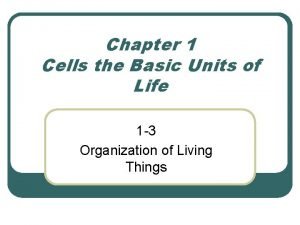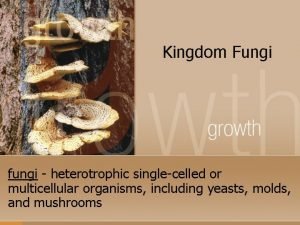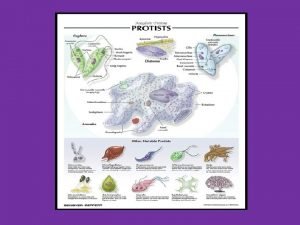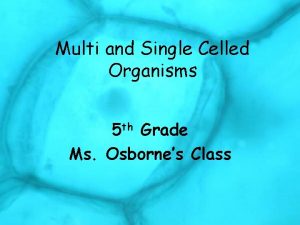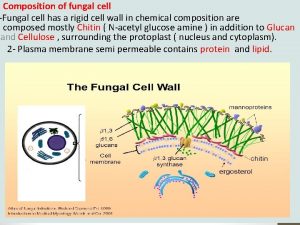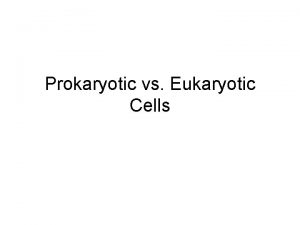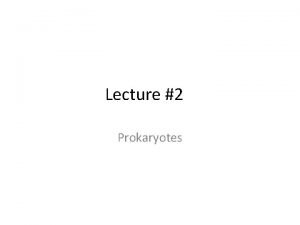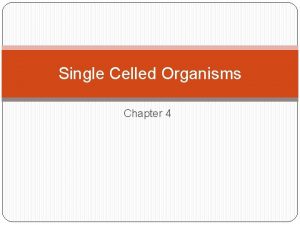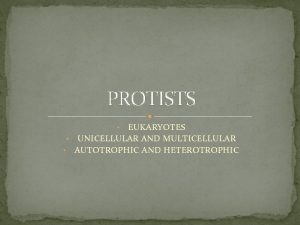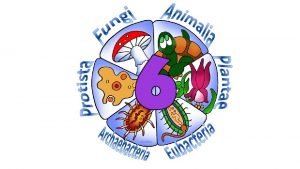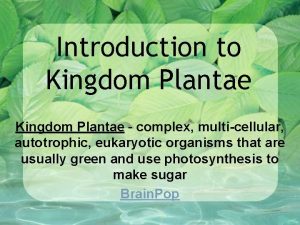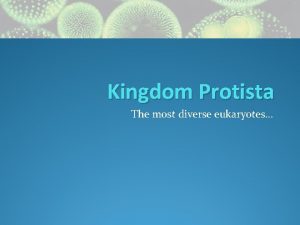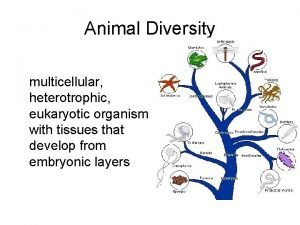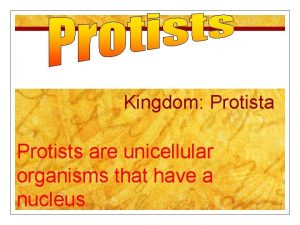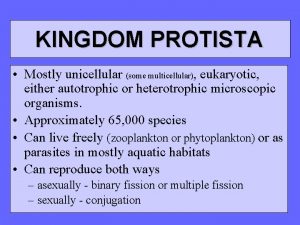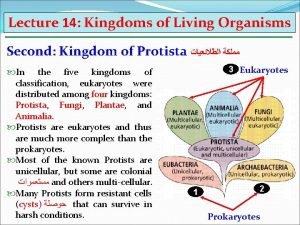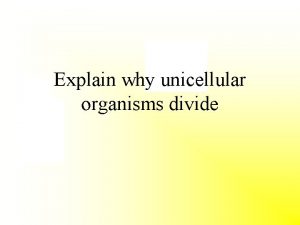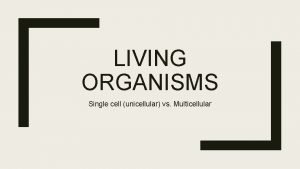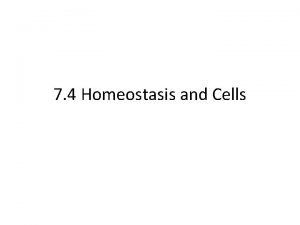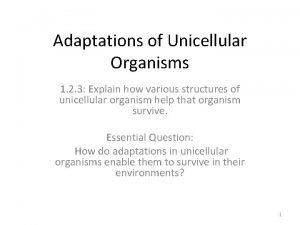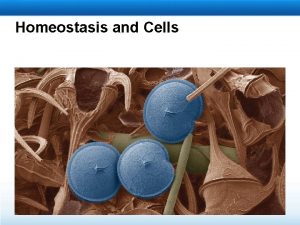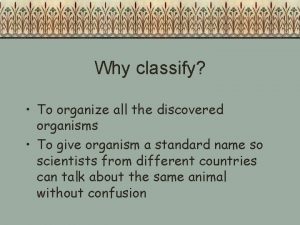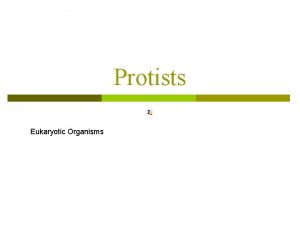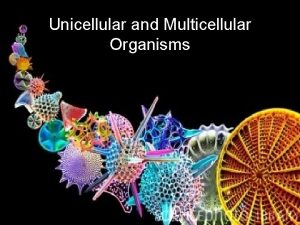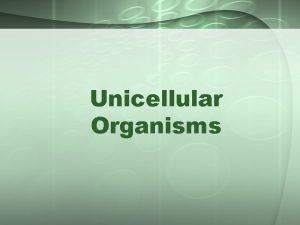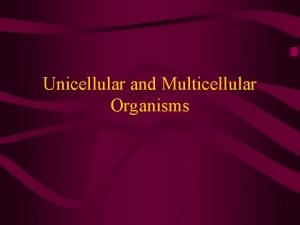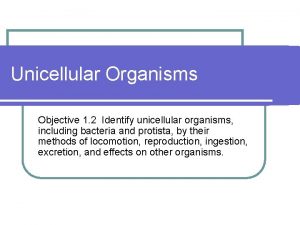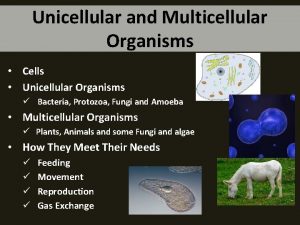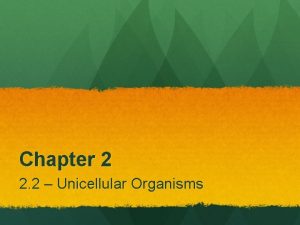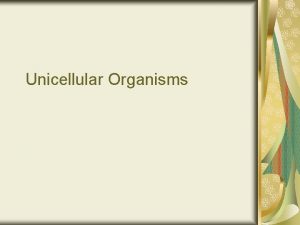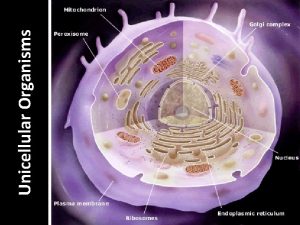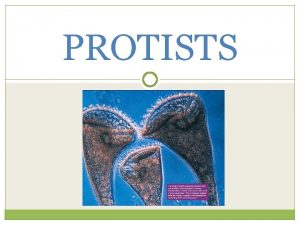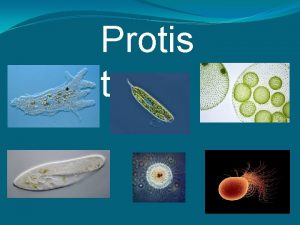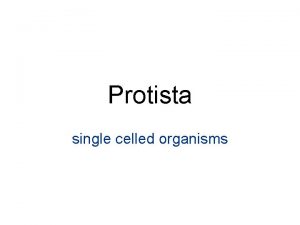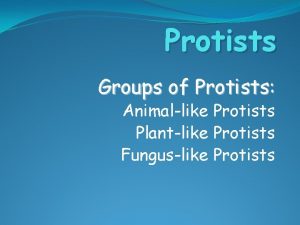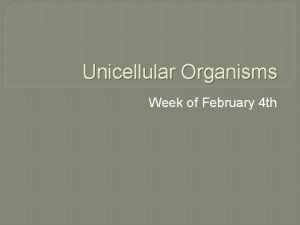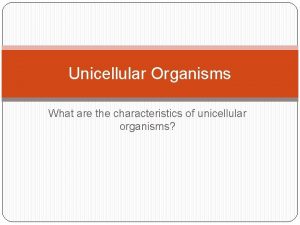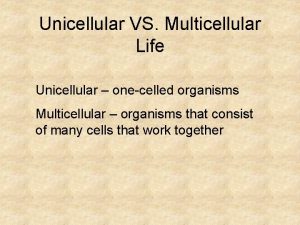PROTISTS PROTISTS unicellular single celled eukaryotic organisms PROTISTS

































- Slides: 33

PROTISTS


PROTISTS unicellular (single celled) eukaryotic organisms

PROTISTS • Evolved about 2 billion years after monera • Characteristics in common with plantae, animalia, and fungi • Protista was created to have a place for all the “unclassified”

Where did protists come from? ENDOSYMBIOSIS HYPOTHESIS

ENDOSYMBIOSIS HYPOTHESIS 1 st eukaryotes were formed by the symbiosis of several prokaryotes

ENDOSYMBIOSIS HYPOTHESIS Proposed by Lynn Margulis

Hypothesis Endosymbiosis

3 TYPES OF PROTISTS • Animal-like • Plant-like • Fungi-like

Animal-like Protists

4 Phyla of Animallike Protists • Ciliophora • Zoomastigina • Sporozoa • Sarcodina

Ciliophora • Aka “cilliates” because they use cillia for movement. • Cillia are hair like projections that work like oars in the water • Example = paramecium

Paramecium

Zoomastigina • Move through the water using flagella • Flagella are long, whiplike projections (like the tail of a sperm)

Zoomastigina

Sporozoa • Non-motile (do not move) • All are parasitic • Reproduce using spores • Example: Plasmodium which causes malaria

Plasmodium falciparum

Sarcodina • Use pseudopods (false foot) for movement • Pseudopods are temporary projections of cytoplasm that help in movement and feeding • Example = amoeba

AMEOBA

Plantlike Protists

3 Phyla of Plantlike Protists • Euglenophyta • Pyrrophyta • Chrysophyta

Euglenophyta • Flagellates with Chloroplasts • Closely related to zoomastinans. • example = euglena

EUGLENA

Pyrophyta • Only eukaryote that does not have histones (proteins that tightly coil DNA) • Most are luminescent (give off light) • Example: Dinoflagellates

Dinoflagellates

Red Tide caused by dinoflagellates

Chrysophyta • Includes yellow-green algae, golden brown algae, diatoms • Example: Diatoms

DIATOM

Funguslike Protists

2 Phyla of Funguslike Protists Both are Slime Molds • Acrasiomycota: cellular slimemolds • Myxomycota: acellular slime molds

Acrasiomycota • AKA Cellular Slime Molds • Spend most of their lives as separate single-celled amoeboid protists • The individual cells may come together into a great swarm

Myxomycota • AKA plasmodial slime molds • Have 1 cell with thousands of nuclei

MYXOMYCOTA
 Unicellular/multicellular
Unicellular/multicellular Name a multicellular organism
Name a multicellular organism One celled plantlike organisms that multiply rapidly
One celled plantlike organisms that multiply rapidly What are three benefits of being multicellular
What are three benefits of being multicellular Are all fungi multicellular
Are all fungi multicellular Protists
Protists Single celled fungi
Single celled fungi Are archaebacteria unicellular or multicellular
Are archaebacteria unicellular or multicellular Unicellular and multicellular organisms 5th grade
Unicellular and multicellular organisms 5th grade Fungal cell wall
Fungal cell wall Organism whose cells contain a nucleus
Organism whose cells contain a nucleus Ciri-ciri chlorella
Ciri-ciri chlorella Microscopic single celled prokaryotes
Microscopic single celled prokaryotes One celled prokaryotes
One celled prokaryotes Are protists autotrophic or heterotrophic
Are protists autotrophic or heterotrophic Is eubacteria unicellular or multicellular
Is eubacteria unicellular or multicellular Are protists autotrophic or heterotrophic
Are protists autotrophic or heterotrophic Kingdom fungi and kingdom plantae similarities
Kingdom fungi and kingdom plantae similarities Which kingdom is autotrophic
Which kingdom is autotrophic The most diverse eukaryotic kingdom is
The most diverse eukaryotic kingdom is Heterotrophic eukaryotic organisms
Heterotrophic eukaryotic organisms Eukaryotic life
Eukaryotic life Are protists unicellular or multicellular
Are protists unicellular or multicellular Are protists unicellular
Are protists unicellular Multicellular protista
Multicellular protista Unicellular living organisms
Unicellular living organisms Why do unicellular organisms divide
Why do unicellular organisms divide Unicellular organisms
Unicellular organisms Unicellular vs multicellular
Unicellular vs multicellular What do unicellular organisms do to maintain homeostasis
What do unicellular organisms do to maintain homeostasis Adaptations of unicellular organisms
Adaptations of unicellular organisms Unicellular vs multicellular organisms
Unicellular vs multicellular organisms Homeostasis in unicellular organisms
Homeostasis in unicellular organisms Nematocyst
Nematocyst



